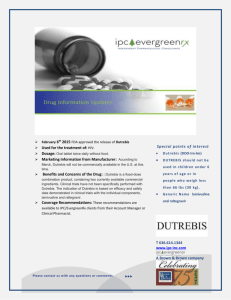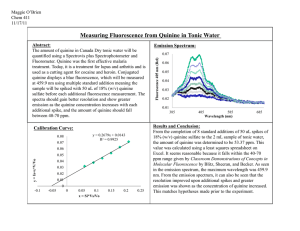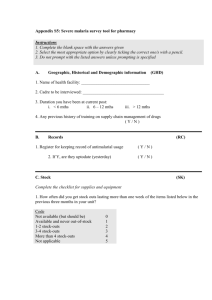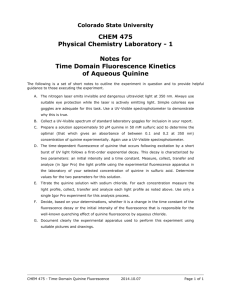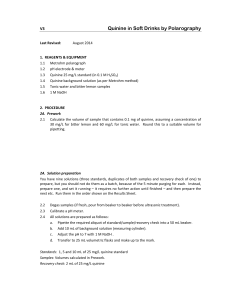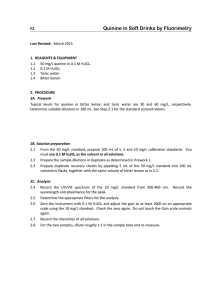Document 13309597
advertisement
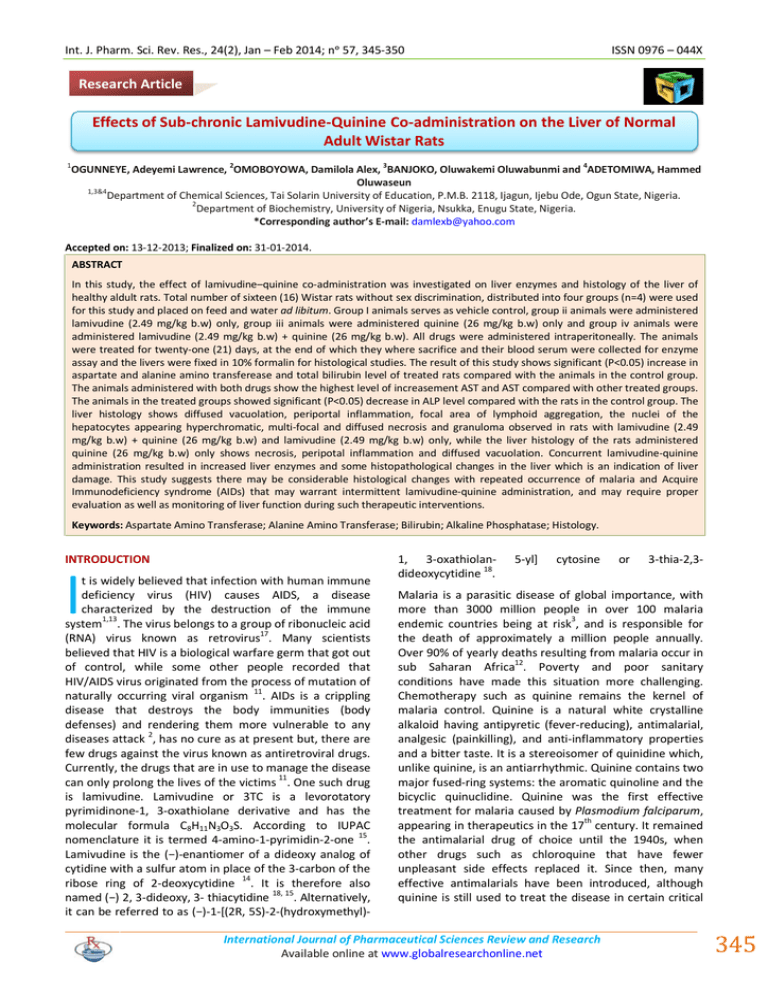
Int. J. Pharm. Sci. Rev. Res., 24(2), Jan – Feb 2014; nᵒ 57, 345-350 ISSN 0976 – 044X Research Article Effects of Sub-chronic Lamivudine-Quinine Co-administration on the Liver of Normal Adult Wistar Rats 1 2 3 4 OGUNNEYE, Adeyemi Lawrence, OMOBOYOWA, Damilola Alex, BANJOKO, Oluwakemi Oluwabunmi and ADETOMIWA, Hammed Oluwaseun 1,3&4 Department of Chemical Sciences, Tai Solarin University of Education, P.M.B. 2118, Ijagun, Ijebu Ode, Ogun State, Nigeria. 2 Department of Biochemistry, University of Nigeria, Nsukka, Enugu State, Nigeria. *Corresponding author’s E-mail: damlexb@yahoo.com Accepted on: 13-12-2013; Finalized on: 31-01-2014. ABSTRACT In this study, the effect of lamivudine–quinine co-administration was investigated on liver enzymes and histology of the liver of healthy aldult rats. Total number of sixteen (16) Wistar rats without sex discrimination, distributed into four groups (n=4) were used for this study and placed on feed and water ad libitum. Group I animals serves as vehicle control, group ii animals were administered lamivudine (2.49 mg/kg b.w) only, group iii animals were administered quinine (26 mg/kg b.w) only and group iv animals were administered lamivudine (2.49 mg/kg b.w) + quinine (26 mg/kg b.w). All drugs were administered intraperitoneally. The animals were treated for twenty-one (21) days, at the end of which they where sacrifice and their blood serum were collected for enzyme assay and the livers were fixed in 10% formalin for histological studies. The result of this study shows significant (P<0.05) increase in aspartate and alanine amino transferease and total bilirubin level of treated rats compared with the animals in the control group. The animals administered with both drugs show the highest level of increasement AST and AST compared with other treated groups. The animals in the treated groups showed significant (P<0.05) decrease in ALP level compared with the rats in the control group. The liver histology shows diffused vacuolation, periportal inflammation, focal area of lymphoid aggregation, the nuclei of the hepatocytes appearing hyperchromatic, multi-focal and diffused necrosis and granuloma observed in rats with lamivudine (2.49 mg/kg b.w) + quinine (26 mg/kg b.w) and lamivudine (2.49 mg/kg b.w) only, while the liver histology of the rats administered quinine (26 mg/kg b.w) only shows necrosis, peripotal inflammation and diffused vacuolation. Concurrent lamivudine-quinine administration resulted in increased liver enzymes and some histopathological changes in the liver which is an indication of liver damage. This study suggests there may be considerable histological changes with repeated occurrence of malaria and Acquire Immunodeficiency syndrome (AIDs) that may warrant intermittent lamivudine-quinine administration, and may require proper evaluation as well as monitoring of liver function during such therapeutic interventions. Keywords: Aspartate Amino Transferase; Alanine Amino Transferase; Bilirubin; Alkaline Phosphatase; Histology. INTRODUCTION I t is widely believed that infection with human immune deficiency virus (HIV) causes AIDS, a disease characterized by the destruction of the immune 1,13 system . The virus belongs to a group of ribonucleic acid (RNA) virus known as retrovirus17. Many scientists believed that HIV is a biological warfare germ that got out of control, while some other people recorded that HIV/AIDS virus originated from the process of mutation of 11 naturally occurring viral organism . AIDs is a crippling disease that destroys the body immunities (body defenses) and rendering them more vulnerable to any 2 diseases attack , has no cure as at present but, there are few drugs against the virus known as antiretroviral drugs. Currently, the drugs that are in use to manage the disease can only prolong the lives of the victims 11. One such drug is lamivudine. Lamivudine or 3TC is a levorotatory pyrimidinone-1, 3-oxathiolane derivative and has the molecular formula C8H11N3O3S. According to IUPAC nomenclature it is termed 4-amino-1-pyrimidin-2-one 15. Lamivudine is the (−)-enantiomer of a dideoxy analog of cytidine with a sulfur atom in place of the 3-carbon of the ribose ring of 2-deoxycytidine 14. It is therefore also named (−) 2, 3-dideoxy, 3- thiacytidine 18, 15. Alternatively, it can be referred to as (−)-1-[(2R, 5S)-2-(hydroxymethyl)- 1, 3-oxathiolandideoxycytidine 18. 5-yl] cytosine or 3-thia-2,3- Malaria is a parasitic disease of global importance, with more than 3000 million people in over 100 malaria 3 endemic countries being at risk , and is responsible for the death of approximately a million people annually. Over 90% of yearly deaths resulting from malaria occur in sub Saharan Africa12. Poverty and poor sanitary conditions have made this situation more challenging. Chemotherapy such as quinine remains the kernel of malaria control. Quinine is a natural white crystalline alkaloid having antipyretic (fever-reducing), antimalarial, analgesic (painkilling), and anti-inflammatory properties and a bitter taste. It is a stereoisomer of quinidine which, unlike quinine, is an antiarrhythmic. Quinine contains two major fused-ring systems: the aromatic quinoline and the bicyclic quinuclidine. Quinine was the first effective treatment for malaria caused by Plasmodium falciparum, appearing in therapeutics in the 17th century. It remained the antimalarial drug of choice until the 1940s, when other drugs such as chloroquine that have fewer unpleasant side effects replaced it. Since then, many effective antimalarials have been introduced, although quinine is still used to treat the disease in certain critical International Journal of Pharmaceutical Sciences Review and Research Available online at www.globalresearchonline.net 345 Int. J. Pharm. Sci. Rev. Res., 24(2), Jan – Feb 2014; nᵒ 57, 345-350 circumstances, such as severe malaria, impoverished regions due to its low cost 7. and in The liver is the processing center of the major metabolic 8 activities in vertebrates and should always be considered in terms of absorption of foreign materials such as foods, drugs etc. to ascertain its high functional status. Most chemical manifestation of liver dysfunction stem from cell damage and impairment of the normal liver capacities, for example, viral hepatitis causes damage and death of hepatocytes. In this case, manifestations may include, increased bleeding (due to decreased synthesis of clotting factors, jaundice (yellow pigmentation due to decreased clearance of bilirubin) and increased levels of circulating hepatocytes enzymes released from dead liver cells8. Hence, the effect of antiretroviral drugs on biochemical indices of liver function is of paramount importance and should not be overlooked. This is to ensure that the liver function is not impaired in the process of managing a particular health problem in case of HIV patient, hoping to minimize the duplication of this virus in the human system, while a lot of harm is being done to the liver 17. Lamivudine and quinine are sometimes co-administered in HIV-Malaria co-morbidity. Both drugs are used concurrently in presumed malaria treatment and simultaneous HIV post exposure prophylaxis. This research is aim to investigate the effect of lamivudinequinine co-administration on the liver function using the liver enzymes and liver histology as indices. MATERIALS AND METHODS All reagents used were of analytical grade. Aspartate amino transferase, Alanine amino transferase, Alkaline phosphatase and Total bilirubin kits were obtained from Randox U.K. All other reagents were supplied by Sigma Incorporated, USA. Drugs Drugs used for this study were lamivudine (Evans), quinine (Tuyil Pharmaceuticals). Both test drugs were of 99.9% analytical grade. Animals Animals used in this study were adult Wistar rats of both sexes, 5-6 weeks old with average weight of 160 ± 14 g. The animals were obtained from the Animal Facility of the Faculty of medical Sciences, University of Ibadan and were used according to the NIH animal care guidelines with approval of the Departmental Animal Committee (DAC/IW-OT/1-07). Animals were placed on food and public water supply ad libitum for the entire duration of the experiment. The animals were allowed to acclimatize with the experimental room for a period of two weeks prior to the commencement of the study. Preparation of Drugs Both quinine and lamivudine were very soluble in distilled water and were prepared using distilled water as vehicle. Required concentrations for administration were prepared from initial stock solutions. ISSN 0976 – 044X Experimental Design Animals were grouped into four groups of four animals (n=4) without sex discrimination. Group i animals serves as vehicle control, group ii animals were administered lamivudine (2.49 mg/kg b.w) only, group iii animals were administered quinine (26 mg/kg b.w) only and group iv animals were administered lamivudine (2.49 mg/kg b.w) + quinine (26 mg/kg b.w). All drugs were administered intraperitoneally. The animals were treated for twentyone (21) days, at the end of which they where sacrifice and their blood serum were collected for enzyme assay and the livers were fixed in 10% formalin for histological studies. Assay method Sera from the animals in the groups were assayed for aspartate amino transferase (AST: EC 2.6.1.1), alanine amino transferase (ALT: EC 2.6.1.2), alkaline phosphatase (ALP: EC 3.1.3.1) and bilirubin using the randox test kits according to the manufacturer’s instructions. Histology The animals were sacrificed and the abdominal cavity of each rat opened, the liver taken out. The organ was fixed in 10% formalin. After complete fixation the blocks was embedded in paraffin and sections cut at 5µm (micron) which was then stained with haematoxylin and eosin and mounted in Canada balsam. Microscopic examination of the sections was then carried out under a light microscope. Statistical Analysis The values were expressed as mean ± SEM. The statistical analysis was carried out by one way analysis of variance (ANOVA). The Pearson value (P<0.05) were considered significant using Statistical Package for Social Sciences (SPSS). RESULTS Effect of Lamivudine and Quinine on the serum Aspartate Amino Transferase (AST) concentration of Rats Fig 1 shows the effect of Lamivudine (2.49 mg/kg b.w) and Quinine (26 mg/kg b.w) in single and combined doses on the Aspartate amino transferase (AST) of normal wistar rats. Animals in the treatment groups (Group 2, 3 and 4) showed significant (P <0.05) increase in AST concentration compared with the animals in the control group (Group 1). Rats administered Quinine (26 mg/kg b.w) only showed significant (P<0.05) decrease in AST level compared with rats administered Lamivudine (2.49 mg/kg b.w) only and Lamivudine (2.49 mg/kg b.w) + Quinine (26 mg/kg b.w). While, animals administered Lamivudine (2.49 mg/kg b.w) + Quinine (26 mg/kg b.w) showed non-significant (P>0.05) increase in AST level compared with rats treated with Lamivudine (2.49 mg/kg b.w) only. International Journal of Pharmaceutical Sciences Review and Research Available online at www.globalresearchonline.net 346 Int. J. Pharm. Sci. Rev. Res., 24(2), Jan – Feb 2014; nᵒ 57, 345-350 Aspartate Amino Transferase (µ/l) 140 100 116 112.75 120 99.91 95.09 80 60 40 20 0 Group 1 Group 2 Group 3 Group 4 Groups Group 1= Control (0.5 ml of distilled water); Group 2= Lamivudine (2.49 mg/kg b.w) only; Group 3= Quinine (26 mg/kg b.w.) only; Group 4= Lamivudine (2.49 mg/kg b.w) + Quinine (26 mg/kg b.w.) ISSN 0976 – 044X Effect of Lamivudine and Quinine on the serum Alkaline phosphatase (ALP) concentration of Rats Fig 3 shows the effect of Lamivudine (2.49 mg/kg b.w) and Quinine (26 mg/kg b.w) in single and combined doses on the serum alkaline phosphatase (ALP) of normal wistar rats. Animals in the treatment groups (Group 2, 3 and 4) showed significant (P <0.05) decrease in ALP concentration compared with the animals in the control group (Group 1). Rats administered Quinine (26 mg/kg b.w) only showed non-significant (P>0.05) increase in ALP level compared with rats administered Lamivudine (2.49 mg/kg b.w) only but a significant (P<0.05) increase in ALP level compared with rats treated with Lamivudine (2.49 mg/kg b.w) + Quinine (26 mg/kg b.w). While, animals administered Lamivudine (2.49 mg/kg b.w) + Quinine (26 mg/kg b.w) showed non-significant (P>0.05) decrease in ALP level compared with rats treated with Lamivudine (2.49 mg/kg b.w) only. Figure 1: Effect of Lamivudine and Quinine on the serum Aspartate Amino Transferase (AST) concentration of Rats Fig 2 shows the effect of Lamivudine (2.49 mg/kg b.w) and Quinine (26 mg/kg b.w) in single and combined doses on the Alanine amino transferase (ALT) of normal wistar rats. Animals in the treatment groups (Group 2, 3 and 4) showed significant (P <0.05) increase in ALT concentration compared with the animals in the control group (Group 1). Rats administered Quinine (26 mg/kg b.w) only showed significant (P<0.05) decrease in ALT level compared with rats administered Lamivudine (2.49 mg/kg b.w) only and Lamivudine (2.49 mg/kg b.w) + Quinine (26 mg/kg b.w). While, animals administered Lamivudine (2.49 mg/kg b.w) + Quinine (26 mg/kg b.w) showed significant (P<0.05) increase in ALT level compared with rats treated with Lamivudine (2.49 mg/kg b.w) only. Alanine Amino Transferase (µ/l) 90 75.59 80 64.49 70 60 44.93 50 40 30 24.4 20 10 0 Group 1 Group 2 Groups Group 3 Group 4 Group 1= Control (0.5 ml of distilled water); Group 2= Lamivudine (2.49 mg/kg b.w) only; Group 3= Quinine (26 mg/kg b.w.) only; Group 4= Lamivudine (2.49 mg/kg b.w) + Quinine (26 mg/kg b.w.) Figure 2: Effect of Lamivudine and Quinine on the serum Alanine Amino Transferase (ALT) concentration of Rats 90 Alkaline phosphatase (µ/l) Effect of Lamivudine and Quinine on the serum Alanine Amino Transferase (ALT) concentration of Rats 100 86 75.1 80 70 56.18 60 50 35.95 40 30 20 10 0 Group 1 Group 2 Group 3 Group 4 Groups Group 1= Control (0.5 ml of distilled water); Group 2= Lamivudine (2.49 mg/kg b.w) only; Group 3= Quinine (26 mg/kg b.w.) only; Group 4= Lamivudine (2.49 mg/kg b.w) + Quinine (26 mg/kg b.w.) Figure 3: Effect of Lamivudine and Quinine on the serum Alkaline phosphatase (ALP) concentration of Rats Effect of Lamivudine and Quinine on the serum total Bilirubin concentration of Rats Fig 4 shows the effect of Lamivudine (2.49 mg/kg b.w) and Quinine (26 mg/kg b.w) in single and combined doses on the serum total bilirubin level of normal wistar rats. Animals in the treated groups (Group 2 and 3) showed non-significant (P>0.05) increase in total bilirubin level compared with the animals in the control group (Group 1), the rats in group 4 administered Lamivudine (2.49 mg/kg b.w) + Quinine (26 mg/kg b.w) showed significant (P<0.05) increase in total bilirubin level compared with the rats in the control group administered distilled water only. Rats administered Quinine (26 mg/kg b.w) only showed non-significant (P>0.05) decrease in total bilirubin level compared with rats administered Lamivudine (2.49 mg/kg b.w) only and Lamivudine (2.49 mg/kg b.w) + Quinine (26 mg/kg b.w). While, animals administered Lamivudine (2.49 mg/kg b.w) + Quinine (26 mg/kg b.w) showed non-significant (P>0.05) increase in total bilirubin International Journal of Pharmaceutical Sciences Review and Research Available online at www.globalresearchonline.net 347 Int. J. Pharm. Sci. Rev. Res., 24(2), Jan – Feb 2014; nᵒ 57, 345-350 ISSN 0976 – 044X level compared with rats treated with Lamivudine (2.49 mg/kg b.w) only. Total Bilirubin (mg/100ml) 2.5 2 1.69 1.63 1.5 1 1.32 0.93 0.5 0 Group 1 Group 2 Group 3 Group 4 Groups Group 1= Control (0.5 ml of distilled water); Group 2= Lamivudine (2.49 mg/kg b.w) only; Group 3= Quinine (26 mg/kg b.w.) only; Group 4= Lamivudine (2.49 mg/kg b.w) + Quinine (26 mg/kg b.w.) Figure 4: Effect of Lamivudine and Quinine on the Bilirubin concentration of Rats a: General Arcitecture (X40) Figure 7: Liver histopathology of Rats administered Quinine (26 mg/kg b.w): Plates show multi-focal and diffused necrosis (green arrow), there is moderate congestion of vessels (blue arrow) and engorgement of the sinusoid (block black arrow), and there was periportal inflammation (red arrow) which extends to zone 2 and 3. There is diffused vacuolation (black arrow). b: Hepatocyte Figure 5: Liver histo-architecture of the control group that was given distilled water showed that the central vein appears normal and the hepato-cytes intact, no pathology and had distinct hepatic cords and sinusoids. Figure 8: Liver histopathology of Rats administered Lamivudine (2.49 mg/kg b.w) + Quinine (26 mg/kg b.w). Plates show multi-focal and diffused necrosis (branching arrow; black arrow), there is moderate congestion of vessels and engorgement of the sinusoid, there is periportal inflammation which extends to zone 2 and 3 also there is diffused vacuolation of hepatocytes. A cyst containing parasite was seen (green arrow) as well as granuloma (blue arrow). DISCUSSION Figure 6: Liver histopathology of Rats administered Lamivudine (2.49 mg/kg b.w): Plates show diffused vacuolation (blue arrow) as well as periportal inflammation (green arrow). There was a focal area of lymphoid aggregate (black arrow). The nuclei of the hepatocytes appear hyperchromatic. Hepatotoxicity is a serious problem especially on those that have been on highly active antiretroviral therapy, 17 limiting their use in the regimen . The liver is prone to Xenobiotics-induced injury because of its central role in xenobiotic metabolism and its portal location within the circulatory system9, 1. Many drugs and chemicals are able 16, 12 to result in adverse forms of liver injury and this may International Journal of Pharmaceutical Sciences Review and Research Available online at www.globalresearchonline.net 348 Int. J. Pharm. Sci. Rev. Res., 24(2), Jan – Feb 2014; nᵒ 57, 345-350 12 result in distortion of liver histology . In the assessment of liver condition after sub-chronic co-administration of Lamivudine (2.49 mg/kg b.w) and Quinine (26 mg/kg b.w), the determination of liver marker enzymes such as AST, ALT, ALP and bilirubin were largely used. The increase in serum alanine amino transferase (ALT), aspartate amino transferase (AST) and total bilirubin level may indicate liver tissue damage probably by altered cell membrane leading to the leakage of the enzyme from the tissues to the serum. Alanine and aspartate amino transferase are considered to be sensitive indicators of hepatocellular damage and within time can provide quantitative 5, 19 evaluation of the degree of damage to the liver . A high level of AST indicates liver damage as well as cardiac infarction and muscle injury4. ALT catalyses the conversion of alanine to pyruvate and glutamate and is released in a similar manner. Therefore, ALT is more specific to the liver and thus, a better parameter for detecting liver injury4. Elevated levels of these serum liver enzymes might indicate liver necrosis especially in rats administered Lamivudine (2.49 mg/kg b.w) + Quinine (26 mg/kg b.w) which significantly (P<0.05) increased more than the concentration of other enzymes assayed in the rats of the other groups. Serum ALP and bilirubin level on the other hand are related to the function of the hepatic cell. Decrease in serum ALP level may be due to decrease in synthesis in the absence of biliary pressure while increase in bilirubin level observed in this study may be as a result of hepatic dysfunction or injury. The exact mechanism by which Lamivudine cause adverse hepatic effect have not been elucidated, but Lee 10, reported that drug induced liver injury occurs via at least six (6) mechanisms involving various intracellular organelles, with consequent disruption of intracellular Calcium homeostasis, decline ATP levels and finally hepatocyte swelling and rupture 6, 20, 17. As indicated by the results of this study, co-adminostration of Lamivudine and quinine (Figure 1, 2 and 4) were associated with significant activities of ALT, AST and total bilirubin. Elevated activities of these enzymes indicated hepatic damage which has result from several mechanisms; generation of 17 toxic species, peroxidaton of membranes; etc. . The histological observation from this study shows that co-administration of lamivudine and quinine and lamivudine only at the dose used in this study caused an abnormal morphology of the liver in which there were diffused vacuolation, periportal inflammation, focal area of lymphoid aggregation, the nuclei of the hepatocytes appearing hyperchromatic, multi-focal and diffused necrosis and granuloma observed in rats with lamivudine (2.49 mg/kg b.w) + quinine (26 mg/kg b.w) and lamivudine (2.49 mg/kg b.w) only, while the liver histology of the rats administered quinine (26 mg/kg b.w) only shows necrosis, peripotal inflannation and difused vacuolation. The histopathological results obtained from 12 this study is in support of the report of which claims abnormal liver histology in the histopathological effect of sub-chronic lamivudine-artesunate co-administration of the liver of diseased adult Wistar rats. ISSN 0976 – 044X CONCLUSION It can be concluded from the result of this work that coadministration of lamivudine and quinine exacerbate the hepatotoxic effect of lamivudine leading to increase in liver enzymes (AST, ALT, bilirubin) and abnormal morphology of the liver in normal Wistar rats. The histopathological consequences of quinine and lamivudine which have been reported in healthy and diseased animals and confirmed in this study may suggest the need for caution and monitoring of hepatic parameters that may be possible markers of histhopathological consequences of the drugs treatment. The co-administration of lamivudine and quinine should be discourage or acute if necessary with proper monitoring. REFERENCES 1. Adesanya OA, Otulana OJ, Huthman IO, Huthman AS, Adesanya RA. Effects of a Single Pill 3-drug Combination of Lamivudine, Nevirapine and Zidovudine on Blood Parameters and Liver Histology in Female Wistar Rats. American Journal of Medicine and Medical Sciences, 2(4), 2012, 71-74. 2. Adler WM. ABC of AIDS. 5th Ed. British Medical Journal Publishing Group, 2001, Pp. 1 -20. 3. Aide P, Bassat Q, Alonso PL. Towards an effective malaria vaccine. Arch Dis Child, 92, 2007, 476-479. 4. Ajithkumar P, Jeganathan NS, Balamurugan K, Radha K. Evaluation of hepato-protective activity of Villorita cyprinoides extract (Black water clams) against paracetamol - induced hepatic injury in albino rats. International Journal of Pharmacy and Biological Sciences, 2(2), 2012, 23-127. 5. Al-Habori M, Al-Aghbari AM, Al-Mamary BM. Toxicological evaluation of Catha Edulis Leaves. A long term feeding experiment in animals. J. Ethnopharmacol., 83, 2002, 209217. 6. Beaunc P, Dansette PM, Mansuy D. Human Antiendoplasmic Reticulum Auto Antibodies Appearing in a Drug-induced Hepatitis are Directed against Human Liver Cytochrome P-450 that Hydroxylates the Drug. Proc. Nat. Acad. Sci., 84, 1987, 551 – 555. 7. FDA. Drug Safety Communication: New risk management plan and patient Medication Guide for Qualaquin (quinine sulfate)". Food and Drug Administration. 2010-08-07. Retrieved 2011-02-21. 8. Garret RH, Grisham CM. Biochemistry. 2nd Edition. Rooks/Cole Thomson Leaning – USA. 1999, Pp. 945 – 6. 9. Jones AL. Anatomy of the normal liver. In: Zakin D, Boyer TD, Eds. Hepatology: a textbook of liver disease, 3rd ed. Philadelphia: WB Saunders, 1996, Pp: 3-32. 10. Lee WM. Drug-induced Hepatotoxicity. New England Journal of Medicine, 349, 2003, 474 485. 11. Okoye C. Helper T Cell Low level Count. Lancet, 300, 2000, 1105. 12. Olurishe TO, Kwanashie HO, Anuka J, Muktar H, Bisalla M. Histopathological effects of sub-chronic lamivudineartesunate co-administration on the liver of diseased adult International Journal of Pharmaceutical Sciences Review and Research Available online at www.globalresearchonline.net 349 Int. J. Pharm. Sci. Rev. Res., 24(2), Jan – Feb 2014; nᵒ 57, 345-350 Wistar rats. North American Journal of Medical Sciences, 3(7), 2011, 325-328. 13. Peter J. South Africa’s New Enemy. Science, 288, 2000, 70 – 100. 14. Soudeyns H, Yao XI, Gao Q, Belleau B, Kraus JL, Nguyen- Ba N, Spira B, Wainberg MA. Anti-human immunodeficiency virus type 1 activity and in vitro toxicity of 2_-deoxy-3_thiacytidine (BCH-189), a novel heterocyclic nucleoside analog. Antimicrob Agents Chemother, 35(7), 1991, 1386– 1390. 15. Strauch S, Jantratid E, Dressman JB, Junginger HE, Kopp S, Midha KK, Shah VP, Stavchansky S, Barends DM. Biowaiver Monographs for Immediate Release Solid Oral Dosage Forms: Lamivudine. Journal of Pharmaceutical Sciences, 100(6), 2011, 2054–2063. 16. Sturgill MG, Lambert GH. Xenobiotic induced Hepatotoxicity: Mechanisms of Liver Injury and Methods of Monitoring Hepatic Function. Clin. Chemistry, 43, 1997, 1512-1526. ISSN 0976 – 044X 17. Sule OJ, Godwin J, Nnopu IA. Biochemical Investigation of Hepatotoxic effects of Antiretroviral Drugs on Wistar Albino Rats. Journal of Physiology and Pharmacology Advances, 2(4), 2012, 171-175. 18. Sweetman S. Martindale: The complete drug reference. Pharmaceutical Press. Accessed January 25, 2010, at: www.medicinescomplete.com/mc/martindale/ current/1381-v.htm. 19. Umana U, Timbuak JA, Musa SA, Hamman WO, Asala S, Hambolu J, Anuka JA. Acute Hepatotoxicity and Nephrotoxicity Study of Orally Administered Aqueous and Ethanolic Extracts of Carica papaya Seeds in Adult Wistar Rats. Asian Journal of Medical Sciences. 5(3), 2013, 65-70. 20. Yun OH, Okerholm RA, Guengerich FP. Oxidation of the Antihistamine Drug Terfenadrine in Human Liver Microsomes: Role of Cytochrome P450 3A4 in Ndealkylation and C-hydroxylation of Drug. Metab. Dispos., 21, 1993, 403 – 409. Source of Support: Nil, Conflict of Interest: None. International Journal of Pharmaceutical Sciences Review and Research Available online at www.globalresearchonline.net 350
